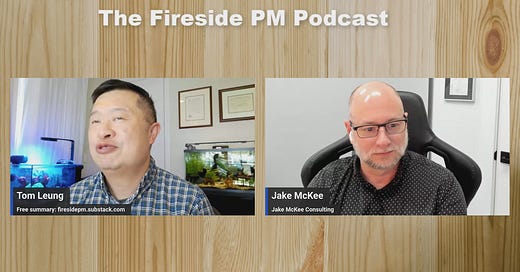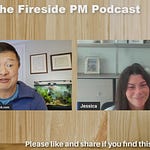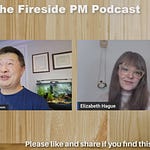Hey Team,
In the latest episode of the Fireside PM podcast, I had the pleasure of chatting with Jake McKee—one of the early advocates of modern community strategy in tech. Jake’s résumé is legit: he’s helped companies like Lego, Apple, and Southwest Airlines transform how they engage their most passionate users—not just as customers, but as collaborators. We covered a ton of ground, and I left the conversation with one overwhelming takeaway:
"Features can be copied. Community relationships are the true moat."
Jake didn’t say that verbatim—but he may as well have. If you're an early- or mid-career product manager trying to build something people will love, advocate for, and stick with, then keep reading. This post is packed with practical advice, examples, and yes—plenty of quotes—to help you rethink how you build products.
From Plastic Bricks to Passionate Builders
Let’s start with Lego. Jake joined the company during a time when the 18+ fan base—the adults building elaborate train sets and sculptures—was considered almost irrelevant. Lego was laser-focused on their core audience: boys ages 7–12.
Jake recalled:
“They weren’t even considered a segment, let alone a priority. When I joined, the adult fans made up 1% of the business. Today it’s closer to 45%.”
How did that shift happen?
Jake and his team didn't just ask adult fans to buy more products—they encouraged them to share their creations, hold public exhibits, and advocate for Lego in the real world. And they did it for free. These superusers weren’t incentivized by checks; they were driven by passion. Jake simply gave them tools and encouragement. He even coached them on things like how to invite media to their events or partner with local retailers for promotions.
“I was whispering in their ear—‘Have you ever thought about getting the media here? Handing out coupons?’ That kind of thing. I was a connector.”
For PMs, the lesson is simple: sometimes the most impactful growth strategy isn’t a new feature—it’s unlocking what your users already want to do.
Community Development ≠ Social Media Management
Before we go further, let’s get clear on what Jake means by “community.”
“It’s the formal and informal, direct and indirect ways to connect the company with customers in a way that leads to shared positivity for both sides.”
This isn’t about launching a Discord or running a Twitter account. It’s about building systems of feedback, advocacy, and co-creation—structures that allow customers to influence product development, feel heard, and ultimately take pride in your company’s success.
And it doesn’t always require a fancy platform. It might look like a customer advisory board. A monthly AMA with your PMs. A product preview group of superusers giving you feedback at the 75% build stage.
It also doesn’t require massive budgets.
“I'd much rather give somebody a T-shirt that has the program name on it—something we came up with together—than a $100 gift card. The card gets forgotten. The T-shirt gets worn for years.”
That example came from his time at Apple, where they created custom luggage tags for top contributors in the support forums. The packaging was signature Apple. The note inside? “Thank you for being on this journey with us.” No gimmicks. Just gratitude.
Community-Driven Product Development: The Framework
Jake has developed a system he calls Community-Driven Product Development (CDPD). It’s a four-part framework that any product team can apply:
Find the Right People
Not just your loudest users, but a cross-section of your audience: new users, power users, skeptics, experts, novices. Diversity isn’t just about demographics—it’s about experience and perspective.Right Timing
Involve users at the right phase of the product cycle. During ideation, you might want 3–4 brainstorming partners. At the 75% mark, you might have 40 people test real workflows. Jake stressed the importance of moving beyond “transactional” feedback loops, like one-off surveys, toward relational ones that evolve over time.Define Outcomes
Be clear on what you’re trying to learn. Is it usability? Emotional resonance? Feature clarity? Align your engagement format with your research questions.Design the Right Activities
Make participation meaningful and rewarding—not necessarily with money, but with access, voice, and recognition.
“The most joy we saw was when our users were talking directly to product managers. And funny enough, the PMs got more energized too. It made the work feel like it mattered again.”
Advice for Silicon Valley PMs
Jake’s message to product managers is blunt: You can’t outsource community to marketing. You can’t delegate empathy to a survey.
“I always say: What’s the ROI of a conversation? Of a relationship? You can’t calculate it with a spreadsheet. But you feel it when it’s gone.”
If you're in the middle of building something, consider these tactical shifts:
Invite users early. Don’t wait until beta to get feedback. Build relationships during ideation and prototype stages.
Create champions. Identify customers who already love your product and ask them to be part of a long-term council or program.
Think about connection, not control. Your job isn’t to “manage” the community—it’s to help the company be more transparent, accessible, and human.
Narrate the journey. Share the “why” behind roadmap decisions. Let users see the people behind the product.
Overcoming Internal Resistance
Jake told a story from his Lego days that really stuck with me. Early on, no one in marketing would accept his meeting invites. So he stood outside their offices and waited for their meetings to end—then slipped in for a five-minute chat.
“That happened enough times that they figured, ‘He’s gonna talk to me anyway—I may as well put him on the calendar.’”
The point? Start small. Be persistent. Show the value through stories, not just decks. Find one internal ally who “gets it” and help them shine.
He also emphasized starting where you are.
“Do something small that you can grow. A T-shirt. A call. A visit. That’s your leverage.”
The Value of Real Relationships
One of my favorite moments from our chat was when Jake described the joy his scale modeling friends bring him compared to showing his creations to his family.
“My family says, ‘That’s cool.’ But my friends? They ask, ‘How did you make that cut? What glue did you use?’ They get it. They care.”
That’s the energy you want between your product team and your users. Not applause. Understanding.
In a world where PMs are drowning in dashboards and AI-generated summaries, that kind of emotional signal is rare—and priceless.
My Own Experience: Two Projects, Two Outcomes
Talking to Jake made me reflect on two product launches I’ve led in the past decade.
In one, we had users in the office every month. We built trust. We showed them early wireframes. We even debated scope and direction together. That product launched smoothly and hit its adoption goals within months.
In another, we did a lot of user research—but it was more transactional. Surveys. Interviews. Data. There was a clear wall between us and the users. The product eventually found its footing, but it took longer and didn’t inspire the same loyalty.
Why? Because in the first example, our users were co-conspirators. In the second, they were “subjects.”
Why This Matters Now
Jake and I talked about AI, and how it’s automating more and more of our day-to-day work. The question becomes: What do we do with the time we save?
“We’re entering a new phase of creative culture. Hobby and craft are more respected now than ever. The next gen gets that.”
That applies to users—but also to us. Community work isn’t some soft, squishy side project. It’s how you future-proof your product and energize your team.
“Nobody is loyal to a brand. They’re loyal to a belief, an experience, a person. If you want loyalty, build those.”
TL;DR: Takeaways for PMs
Here’s your tactical cheat sheet:
✅ Start early. Bring users into the conversation before the roadmap is locked.
✅ Build relationships. Find 5–10 users who are willing to go deeper than surveys.
✅ Share your why. Don’t just ask for feedback—share your constraints and goals.
✅ Create artifacts. T-shirts, notes, community-only events—they go further than money.
✅ Help your PMs feel human. Let them talk to real users. It will energize the team.
✅ Use community to de-risk launches. Your best advocates are built before launch day.
✅ Make it sustainable. One-time research projects are fine, but community is a flywheel.
Learn more about Jake here.
If you found this valuable and want to build a more community-driven product culture at your company, I’d love to help.
👉 For product leadership coaching: tomleungcoaching.com
👉 For fractional CPO and consulting work: paloaltofoundry.com
Let’s build products people care about.
Aright, enough talking. Let’s get back to work!












Share this post